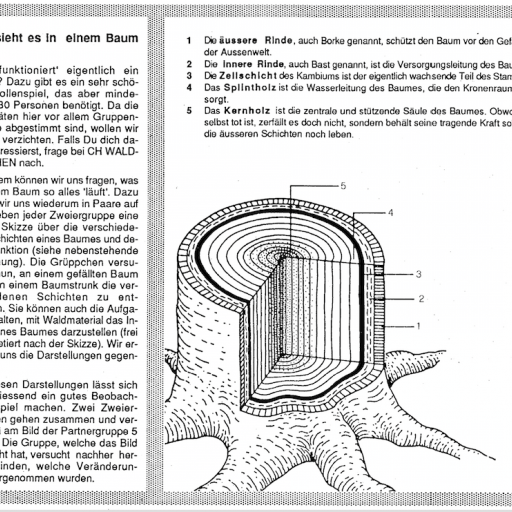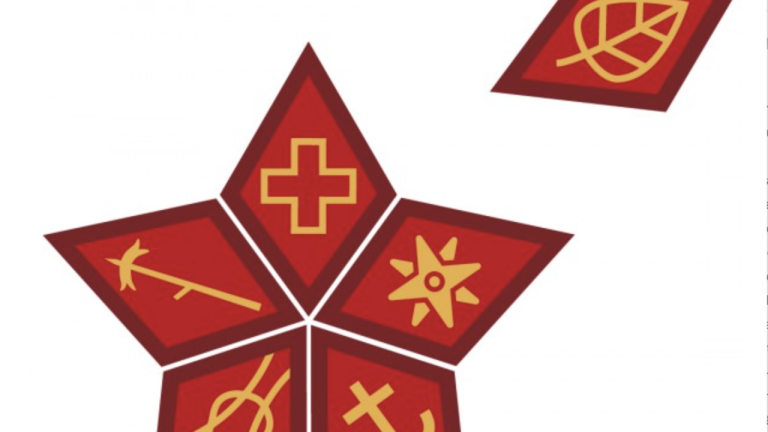We get to know the forest as a habitat for plants in an experiential way. "Knowing" here means much more than just knowing the names. We learn about the characteristics and nature of plant life and try to get closer to them in different ways
Getting to know leaves, trees etc.
Forest leaves
The leader collects 15-20 different leaves of forest plants, of which at least 8-10 should be from shrubs and trees.
The leader spreads out the different leaves on a white cloth. Then the group divides into pairs. The pairs also receive a cloth and lay it on the forest floor. Each pair looks for the 15-20 leaves in the forest, exactly the same as those on the leader's cloth.
After the collection of leaves is completed, they decide with each other which leaves belong to shrubs or trees and which should be counted among the group of other forest plants.
Each group of two then sits down behind their leaves and arranges them according to the above subdivisions (tree / shrub / other forest plants). To set the stage for the next step, they look closely at each leaf.
Every two pairs now sit opposite each other and hold the cloth in such a way that the other party cannot see the arrangement of their own leaves (e.g. hold up half of the cloth and place the leaves on the half that remains on the ground). One group of two agrees on a leaf and the other group tries to find out which leaf the other group has remembered by asking specific questions.
The questions should be about characteristics of the different leaves, so for example, "Is the edge of the leaf without incisions?" or "Is the bottom of the leaf lighter than the top?" etc
After a leaf is "unraveled," the two groups of two switch roles. Next, we want to learn about the plants of the forest that belong to the leaves in their entirety.
With each other, 4-8 leaves of shrubs or trees are chosen, yes, according to the age group. Each group of two goes into the forest with their leaves and looks again for the plants belonging to them. It is not to be looked for the first-best specimen of a shrub or tree, but really one, with which one would like to deal. In addition, you also get around a bit in the forest if the search is on a somewhat larger scale.
Note:
The leaf guessing game might become more exciting if certain rules are introduced. E.g. only 5 questions are available per hand. If the hand is not guessed, there is a negative point. If the correct hand is found out without using the 5 questions, the group gets 3 points, but if the wrong hand is guessed, 3 negative points are awarded. Whoever gets the hand out after the allowed 5 questions gets one point. Instead of points, the game can also be played for pine cones. Of the 20 leaves, about 10 should be guessed this way (each group is free to choose).
Tree identification:
- Bark, leaves, twigs, character, features, mass
- Tree life
- Partner touch game
- "My" tree
- Finding the tree again
- What does it look like inside a tree?
Source reference:
Content: Klemens Niederberger with the collaboration of CH WALDWOCHEN in den Schweiz. Children's and Youth Associations, 1990?
Patronage:
- Federal Councillor Flavio Cotti, FDHA
- Forestry Directors' Conference (FDK)
- Education Directors' Conference (EDK)
Promoters:
- Schweiz. Zentrum f. Umwelterziehung (SZU)
- World Wildlife Fund (WWF)
- Schweiz. Bund f. Naturschutz (SBN)
- Bundesamt f. Umwelt, Wald und Landschaft (BUWAL)
- Eid. Research Institute for Forests, Snow and Landscape (WSL)
- Forestry Central Office (FZ)
- Swiss Foresters Association (VSF/ASF)
- Swiss Forestry Association (FZ). Foresters (VSF/ASF)
- Schweiz. Arbeitsgemeinschaft der Jugendverbände (SAJV)
- Dachverband Lehrer und Lehrerinnen Schweiz (LCH)
- Forum schweiz. Elternorganisationen (FSEO) c
copyright: CH Forest Weeks, Zofingen
Photos: Klemens Niederberger, Peter Frey, Philippe Pomont and others
Content may be automatically translated. Help improve the quality of the translation with your editing!





